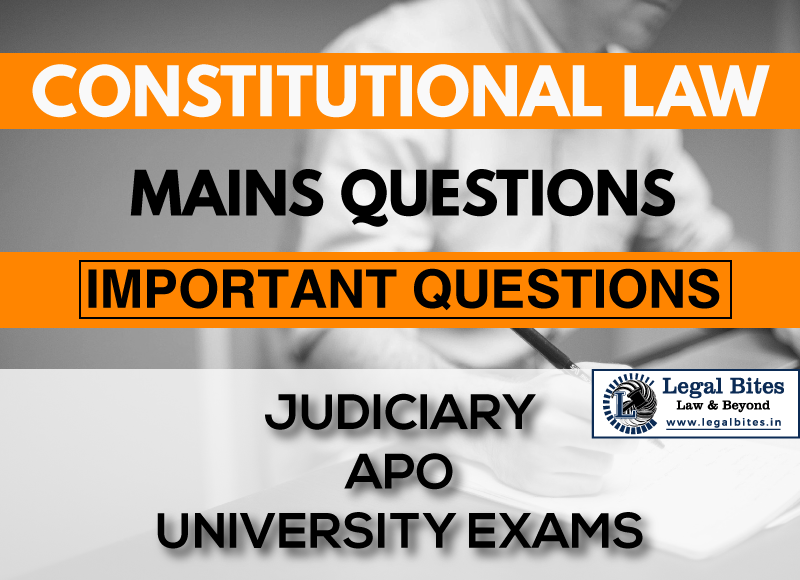How far judicial decisions, interpreting constitutional provisions, relating to appointment and transfer of Judges have affected established principles of Constitutional Law?
Find the answer to the mains question of Constitutional Law only on Legal Bites.

Question: How far judicial decisions, interpreting constitutional provisions relating to the appointment and transfer of Judges have, affected established principles of Constitutional Law? [UPJS 2006]
Find the answer to the mains question only on Legal Bites. [How far judicial decisions, interpreting constitutional provisions, relating to appointment and transfer of Judges have affected established principles of Constitutional Law?]
Answer
The first case was Marbury v. Madison, [(1803) 1 Cr 137.] which ruled that it is the duty of every judge in the United States to treat as void any enactment which violates the Constitution. The Court cannot properly decline to exercise this power. This has led to the establishment of the doctrine of judicial supremacy. Since then, the supremacy and independence and impartiality of the Indian Courts have been dealt with by the judiciary through many cases.
The transfer of judges of the higher judiciary being one of the essentials which affect the independence and functioning of the judiciary was discussed in Union of India v. Sankalchand Himatlal Sheth, AIR 1977 SC 2328. However, the Supreme Court ruled that the President had the power to transfer judges with neither their consent nor the ‘concurrence’ of the Chief Justice of India (CJI). It was an assault on the independence of the judiciary because of the interference of the executive in the appointment process. Following this, there were three cases that marked the journey of the finalizing of the system for the appointment of judges.
The first case is S.P Gupta v. Union of India (1981). In this case, the Court decided that the word ‘consultation’ does not mean ‘concurrence’ and that the President would have the final say in making a decision with respect to the appointment of judges. It also held that the only two grounds on which the Executive’s decision could be questioned was if it was based on irrelevant considerations or if it was mala fide. This case kept the supremacy of the Executive in appointing judges, intact.
The second case was Supreme Court Advocate-on-Record Association v. Union of India (1993). In this case, the first judge's case was overruled. The Court held that in the event of a conflict between the opinion of the Chief Justice of India and the President, the opinion of the Chief Justice of India should prevail. It was also decided that from then onwards, a collegium shall be formed, which shall decide the appointment of judges to the Supreme Court and the High Court.
This Collegium shall consist of the Chief Justice of India and two senior-most judges of the Supreme Court for the matter of appointment of judges in the Supreme Court and the Chief Justice of the High and two senior-most judges of the High Court, with respect to the appointment of judges in the High Court. Laying down the foundation for judicial supremacy in the matter of appointment of judges in the Courts and maintaining judicial independence, this case became the second pillar in the journey of appointment of judges.
The third judge case (1998) was under a reference to the Supreme Court by the President of India. This reference happened due to a controversy in which the Chief Justice of India gave the names to the President of India, for assent, without consultation with the two senior-most judges of the Supreme Court. The Court held that advice given by the Chief Justice in this matter, without consulting the collegium, would not be binding on the government. The Court also expanded the collegium to include four senior-most judges instead of just two, besides the Chief Justice of India.
When through the 99th constitutional amendment, the collegium system was sought to be replaced by the National Judicial Appointments Commission, the Supreme Court swiftly struck it down in the Fourth Judges Case (2015) and ruled that the primacy of the collegium was a part of the Constitution’s basic structure, and this power could not, therefore, be removed even through a constitutional amendment.
Important Mains Questions Series for Judiciary, APO & University Exams
- Constitutional Law Mains Questions Series Part-I
- Constitutional Law Mains Questions Series Part-I
- Constitutional Law Mains Questions Series Part-II
- Constitutional Law Mains Questions Series Part-IV
- Constitutional Law Mains Questions Series Part-V
- Constitutional Law Mains Questions Series Part-VI
- Constitutional Law Mains Questions Series Part-VII
- Constitutional Law Mains Questions Series Part-VIII
- Constitutional Law Mains Questions Series Part-IX
- Constitutional Law Mains Questions Series Part-X
